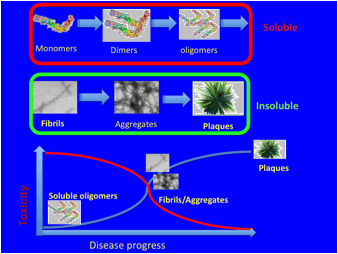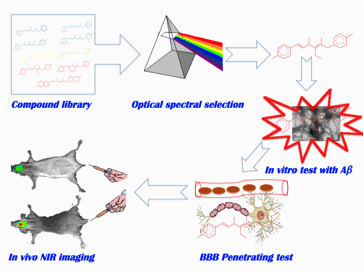Research
Fluorescence Imaging Probe Development
The Amyloid β (Aβ) species of Alzheimer’s disease (AD) has been considered to be an important biomarker family. In the course of AD development, Aβ monomers gradually polymerize/aggregate/cross-link into higher molecular weight (HMW) species that include soluble small oligomers such as dimers, tetramers, large oligomers, profibrils, insoluble fibrils/aggregates, and plaques. Insoluble Amyloid beta plaques (the current targeted biomarkers of a few clinical/preclinical diagnosis agents) are one of the important hallmarks at symptomatic stages and present the ending products of molecular pathological abnormality. Soluble Amyloid beta species are considered to be biomarkers of the presymptomatic stage and early products of molecular abnormality.

Picture 2: Full course of Amyloidosis
This work is intended to design and synthesize a small compound library that consists of novel “smart” Near-Infrared Imaging probes. The most desirable probes will be picked out based on their “smartness” towards Amyloid beta peptides, BBB penetrating ability, and capability for fluorescence imaging and toxicity.
Currently, our probe design is primarily based on the Curcumin structure. Curcumin, the principal curcuminoid of the Indian curry, has been reported for its antitumor, antioxidant, antiarthritic, and anti-inflammatory properties and has also been used as an anti-Amyloid agent. Studies show that curcumin has specificity for Amyloid plaque and displays high affinity binding for Aβ aggregates. Based on the core structure of curcumin, our research group has successfully designed several analogues that could be considered as “smart” NIR probes based on significant changes of several fluorescence properties: an increase in fluorescence intensity, prolonged lifetime, a shift in emission peak upon binding to Aβ aggregates, monomeric Aβ40/42, and even a core segment of the Aβ peptide.

Picture 3: Cartoon of screening
